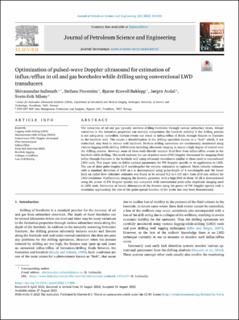| dc.contributor.author | Indimath, Shivanandan | |
| dc.contributor.author | Fiorentini, Stefano | |
| dc.contributor.author | Bøklepp, Bjarne Rosvoll | |
| dc.contributor.author | Avdal, Jørgen | |
| dc.contributor.author | Måsøy, Svein-Erik | |
| dc.date.accessioned | 2022-12-07T12:56:31Z | |
| dc.date.available | 2022-12-07T12:56:31Z | |
| dc.date.created | 2022-09-06T14:19:13Z | |
| dc.date.issued | 2022 | |
| dc.identifier.issn | 0920-4105 | |
| dc.identifier.uri | https://hdl.handle.net/11250/3036368 | |
| dc.description.abstract | The extraction of oil and gas typically involves drilling boreholes through various subsurface strata. Abrupt variations in the formation properties can severely compromise the borehole stability if the drilling process is not adequately controlled. Certain events can result in influx/efflux of fluids through fissures or fractures in the borehole wall. This causes a destabilization in the drilling operation known as a “kick” which, if not controlled, may lead to serious well incidents. Modern drilling operations are continuously monitored using various logging-while-drilling (LWD) tools including ultrasonic imaging to assure a high degree of control over the drilling process. However, none of these tools directly monitor fluid flow from influx/efflux events in the borehole while drilling. This work explores the use of pulsed-wave (PW) Doppler ultrasound for mapping fluid influx through fractures in the borehole wall using ultrasonic transducers similar to those used in conventional LWD tools. This paper aims to define optimal parameters for PW Doppler specific to its application in LWD. The use of short pulse-lengths (2–4 wavelengths) for velocity estimation is explored. Mean velocity estimates with a standard deviation of 0.05 m/s is demonstrated using pulse-length of 4 wavelengths and the lower limit on radial flow velocities estimates was found to be around 0.2 m/s (15 ml/s from 10 mm orifice) for LWD conditions. Furthermore, imaging the fracture geometry with a high SNR of about 30 dB is demonstrated using the power of PW Doppler spectra and compared with conventional pulse-echo amplitude imaging used in LWD tools. Estimation of lateral dimensions of the fracture using the power of PW Doppler spectra with a resolution approaching the size of the point-spread function of the probe has also been demonstrated. | en_US |
| dc.description.abstract | Optimization of pulsed-wave Doppler ultrasound for estimation of influx/efflux in oil and gas boreholes while drilling using conventional LWD transducers | en_US |
| dc.language.iso | eng | en_US |
| dc.publisher | Elsevier Science | en_US |
| dc.relation.uri | https://doi.org/10.1016/j.petrol.2022.111000 | |
| dc.rights | Navngivelse 4.0 Internasjonal | * |
| dc.rights.uri | http://creativecommons.org/licenses/by/4.0/deed.no | * |
| dc.title | Optimization of pulsed-wave Doppler ultrasound for estimation of influx/efflux in oil and gas boreholes while drilling using conventional LWD transducers | en_US |
| dc.title.alternative | Optimization of pulsed-wave Doppler ultrasound for estimation of influx/efflux in oil and gas boreholes while drilling using conventional LWD transducers | en_US |
| dc.type | Peer reviewed | en_US |
| dc.type | Journal article | en_US |
| dc.description.version | publishedVersion | en_US |
| dc.source.volume | 218 | en_US |
| dc.source.journal | Journal of Petroleum Science and Engineering | en_US |
| dc.identifier.doi | https://doi.org/10.1016/j.petrol.2022.111000 | |
| dc.identifier.cristin | 2049214 | |
| cristin.ispublished | true | |
| cristin.fulltext | original | |
| cristin.qualitycode | 2 | |

